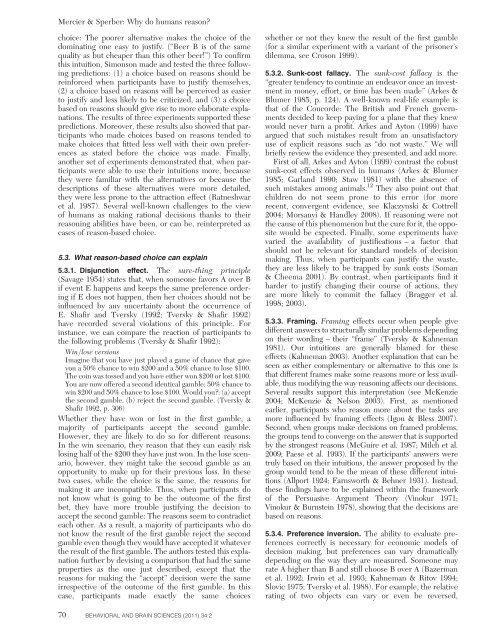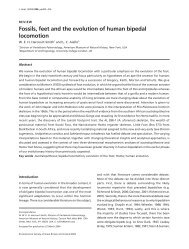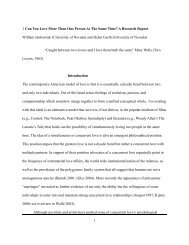Why do humans reason? Arguments for an argumentative theory
Why do humans reason? Arguments for an argumentative theory
Why do humans reason? Arguments for an argumentative theory
Create successful ePaper yourself
Turn your PDF publications into a flip-book with our unique Google optimized e-Paper software.
Mercier & Sperber: <strong>Why</strong> <strong>do</strong> <strong>hum<strong>an</strong>s</strong> <strong>reason</strong>?choice: The poorer alternative makes the choice of the<strong>do</strong>minating one easy to justify. (“Beer B is of the samequality as but cheaper th<strong>an</strong> this other beer!”) To confirmthis intuition, Simonson made <strong>an</strong>d tested the three followingpredictions: (1) a choice based on <strong>reason</strong>s should berein<strong>for</strong>ced when particip<strong>an</strong>ts have to justify themselves,(2) a choice based on <strong>reason</strong>s will be perceived as easierto justify <strong>an</strong>d less likely to be criticized, <strong>an</strong>d (3) a choicebased on <strong>reason</strong>s should give rise to more elaborate expl<strong>an</strong>ations.The results of three experiments supported thesepredictions. Moreover, these results also showed that particip<strong>an</strong>tswho made choices based on <strong>reason</strong>s tended tomake choices that fitted less well with their own preferencesas stated be<strong>for</strong>e the choice was made. Finally,<strong>an</strong>other set of experiments demonstrated that, when particip<strong>an</strong>tswere able to use their intuitions more, becausethey were familiar with the alternatives or because thedescriptions of these alternatives were more detailed,they were less prone to the attraction effect (Ratneshwaret al. 1987). Several well-known challenges to the viewof <strong>hum<strong>an</strong>s</strong> as making rational decisions th<strong>an</strong>ks to their<strong>reason</strong>ing abilities have been, or c<strong>an</strong> be, reinterpreted ascases of <strong>reason</strong>-based choice.5.3. What <strong>reason</strong>-based choice c<strong>an</strong> explain5.3.1. Disjunction effect. The sure-thing principle(Savage 1954) states that, when someone favors A over Bif event E happens <strong>an</strong>d keeps the same preference orderingif E <strong>do</strong>es not happen, then her choices should not beinfluenced by <strong>an</strong>y uncertainty about the occurrence ofE. Shafir <strong>an</strong>d Tversky (1992; Tversky & Shafir 1992)have recorded several violations of this principle. Forinst<strong>an</strong>ce, we c<strong>an</strong> compare the reaction of particip<strong>an</strong>ts tothe following problems (Tversky & Shafir 1992):Win/lose versionsImagine that you have just played a game of ch<strong>an</strong>ce that gaveyou a 50% ch<strong>an</strong>ce to win $200 <strong>an</strong>d a 50% ch<strong>an</strong>ce to lose $100.The coin was tossed <strong>an</strong>d you have either won $200 or lost $100.You are now offered a second identical gamble: 50% ch<strong>an</strong>ce towin $200 <strong>an</strong>d 50% ch<strong>an</strong>ce to lose $100. Would you?: (a) acceptthe second gamble. (b) reject the second gamble. (Tversky &Shafir 1992, p. 306)Whether they have won or lost in the first gamble, amajority of particip<strong>an</strong>ts accept the second gamble.However, they are likely to <strong>do</strong> so <strong>for</strong> different <strong>reason</strong>s:In the win scenario, they <strong>reason</strong> that they c<strong>an</strong> easily risklosing half of the $200 they have just won. In the lose scenario,however, they might take the second gamble as <strong>an</strong>opportunity to make up <strong>for</strong> their previous loss. In thesetwo cases, while the choice is the same, the <strong>reason</strong>s <strong>for</strong>making it are incompatible. Thus, when particip<strong>an</strong>ts <strong>do</strong>not know what is going to be the outcome of the firstbet, they have more trouble justifying the decision toaccept the second gamble: The <strong>reason</strong>s seem to contradicteach other. As a result, a majority of particip<strong>an</strong>ts who <strong>do</strong>not know the result of the first gamble reject the secondgamble even though they would have accepted it whateverthe result of the first gamble. The authors tested this expl<strong>an</strong>ationfurther by devising a comparison that had the sameproperties as the one just described, except that the<strong>reason</strong>s <strong>for</strong> making the “accept” decision were the sameirrespective of the outcome of the first gamble. In thiscase, particip<strong>an</strong>ts made exactly the same choiceswhether or not they knew the result of the first gamble(<strong>for</strong> a similar experiment with a vari<strong>an</strong>t of the prisoner’sdilemma, see Croson 1999).5.3.2. Sunk-cost fallacy. The sunk-cost fallacy is the“greater tendency to continue <strong>an</strong> endeavor once <strong>an</strong> investmentin money, ef<strong>for</strong>t, or time has been made” (Arkes &Blumer 1985, p. 124). A well-known real-life example isthat of the Concorde: The British <strong>an</strong>d French governmentsdecided to keep paying <strong>for</strong> a pl<strong>an</strong>e that they knewwould never turn a profit. Arkes <strong>an</strong>d Ayton (1999) haveargued that such mistakes result from <strong>an</strong> unsatisfactoryuse of explicit <strong>reason</strong>s such as “<strong>do</strong> not waste.” We willbriefly review the evidence they presented, <strong>an</strong>d add more.First of all, Arkes <strong>an</strong>d Ayton (1999) contrast the robustsunk-cost effects observed in <strong>hum<strong>an</strong>s</strong> (Arkes & Blumer1985; Garl<strong>an</strong>d 1990; Staw 1981) with the absence ofsuch mistakes among <strong>an</strong>imals. 12 They also point out thatchildren <strong>do</strong> not seem prone to this error (<strong>for</strong> morerecent, convergent evidence, see Klaczynski & Cottrell2004; Mors<strong>an</strong>yi & H<strong>an</strong>dley 2008). If <strong>reason</strong>ing were notthe cause of this phenomenon but the cure <strong>for</strong> it, the oppositewould be expected. Finally, some experiments havevaried the availability of justifications – a factor thatshould not be relev<strong>an</strong>t <strong>for</strong> st<strong>an</strong>dard models of decisionmaking. Thus, when particip<strong>an</strong>ts c<strong>an</strong> justify the waste,they are less likely to be trapped by sunk costs (Som<strong>an</strong>& Cheema 2001). By contrast, when particip<strong>an</strong>ts find itharder to justify ch<strong>an</strong>ging their course of actions, theyare more likely to commit the fallacy (Bragger et al.1998; 2003).5.3.3. Framing. Framing effects occur when people givedifferent <strong>an</strong>swers to structurally similar problems dependingon their wording – their “frame” (Tversky & Kahnem<strong>an</strong>1981). Our intuitions are generally blamed <strong>for</strong> theseeffects (Kahnem<strong>an</strong> 2003). Another expl<strong>an</strong>ation that c<strong>an</strong> beseen as either complementary or alternative to this one isthat different frames make some <strong>reason</strong>s more or less available,thus modifying the way <strong>reason</strong>ing affects our decisions.Several results support this interpretation (see McKenzie2004; McKenzie & Nelson 2003). First, as mentionedearlier, particip<strong>an</strong>ts who <strong>reason</strong> more about the tasks aremore influenced by framing effects (Igou & Bless 2007).Second, when groups make decisions on framed problems,the groups tend to converge on the <strong>an</strong>swer that is supportedby the strongest <strong>reason</strong>s (McGuire et al. 1987; Milch et al.2009; Paese et al. 1993). If the particip<strong>an</strong>ts’ <strong>an</strong>swers weretruly based on their intuitions, the <strong>an</strong>swer proposed by thegroup would tend to be the me<strong>an</strong> of these different intuitions(Allport 1924; Farnsworth & Behner 1931). Instead,these findings have to be explained within the frameworkof the Persuasive Argument Theory (Vinokur 1971;Vinokur & Burnstein 1978), showing that the decisions arebased on <strong>reason</strong>s.5.3.4. Preference inversion. The ability to evaluate preferencescorrectly is necessary <strong>for</strong> economic models ofdecision making, but preferences c<strong>an</strong> vary dramaticallydepending on the way they are measured. Someone mayrate A higher th<strong>an</strong> B <strong>an</strong>d still choose B over A (Bazerm<strong>an</strong>et al. 1992; Irwin et al. 1993; Kahnem<strong>an</strong> & Ritov 1994;Slovic 1975; Tversky et al. 1988). For example, the relativerating of two objects c<strong>an</strong> vary or even be reversed,70 BEHAVIORAL AND BRAIN SCIENCES (2011) 34:2




